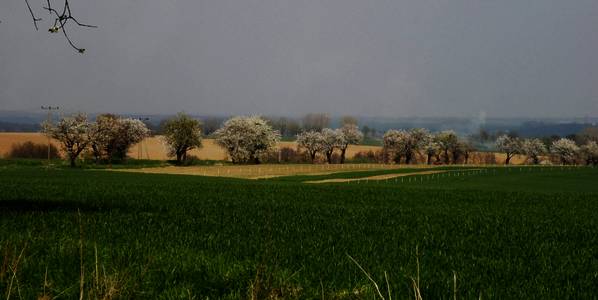
Traditional orchards in Poland
The history of traditional orchards in Poland dates back to the 11th century. At that time Benedictine monks arrived in Poland, bringing in initial varieties of fruit trees. The Benedictine monastery in Tyniec (near Krakow – south Poland) became a centre of agriculture. Its abbot, described as “the abbot of a hundred villages”, owned a lot of land, on which priests had planted apple- and pear trees, which from there spread across Mazovia and Prussia (Central and North Poland).
Soon gardens with fruit trees were established in other order's monasteries, castles, manors and peasants' farms. This marks the appearance of standard trees in home- or traditional orchards in rural Polish landscapes. Their development was particularly improved during 18th, 19th and partially 20th century. At that time Polish rural landscapes were characterise by flowering fruit trees. Fruit processing became an important part of culinary habits.
Commercial orchards with new varieties
The second part of the 20th century marks the beginning of commercial orchards with new varieties imported from the USA. Encouraged by state’s policies and access to new varieties farmers cut down many old orchards, to be replaced by densely planted half-standard trees, prone to disease.
As a result, today Poland has two types of traditional orchards: established before 1950, with varieties cultivated in the 18th and 19th centuries (whose fruits are rarely infected by disease) and orchards with varieties introduced to cultivation in the 1960s.
In the 70s several gene banks for old varieties were created within scientific institutes: Arboretum in Bolestraszyce (southern Poland); Institute of Orchards and Flowers in Skierniewice (central Poland); Botanical Garden of the Polish Academy of Science in Powsin (near to Warsaw).
First initiatives to protect and promote old varieties weren't started until the beginning 21st century by environmental NGOs. Many projects have run throughout Poland. They emphasise the importance of traditional orchards to the ecosystem, teach farmers how to take care of the old orchards and how to plant new orchards with old varieties. Additionally, nurseries with old varieties and regional collections were established and traditional fruit processing was reintroduced.
Pomologists have developed a model of a traditional orchard consisting of up to several dozens of standard trees (different varieties) planted in wide raw distance, with almost natural crowns. Owner of such orchards can apply to agro-environmental programmes to receive support for their preservation (Package 6.4. - 500 EUR ha/year).
According to plans of the Ministry of Agriculture, until 2013, more than 25.000 orchards, only representing a small percentage of all existing orchards, are to receive this subsidies. For about ten years now, the law permits the reproduction of formerly cultivated varieties. However, a lack of basic knowledge about old varieties, care and cultivation of standard trees, as well as Polish regulations for local processing severely limit the creation of new traditional orchards.
Increased interest in old varieties
In recent years, the work of NGOs and scientific institutions has increased people's interest in planting old varieties. On the consumer's side, a grown interest in health values, has presented an increased demand for those variety's produce. Fruit from old varieties is irreplaceable to Polish recipes for making jam, juice, compote or liquor. New trends can also be observed: Traditional orchards are established in places were ecological awareness is higher – agro-tourism farms, organic farms, farms purchased by people, who value the beauty of the landscapes by moving to the countryside. The tradition of an orchard near the farmer’s house is still alive. When names, such as Kosztela (an apple loved by famous Queen Marysieńka) are brought up, people remember the unique smell and taste of an old Polish apple.
Polish rural landscapes are rich in biodiversity due to the structure of the Polish agriculture; traditional orchards are an important part of this biodiversity and can once again become an important part of Polish farmers’ and local producers’ incomes.







